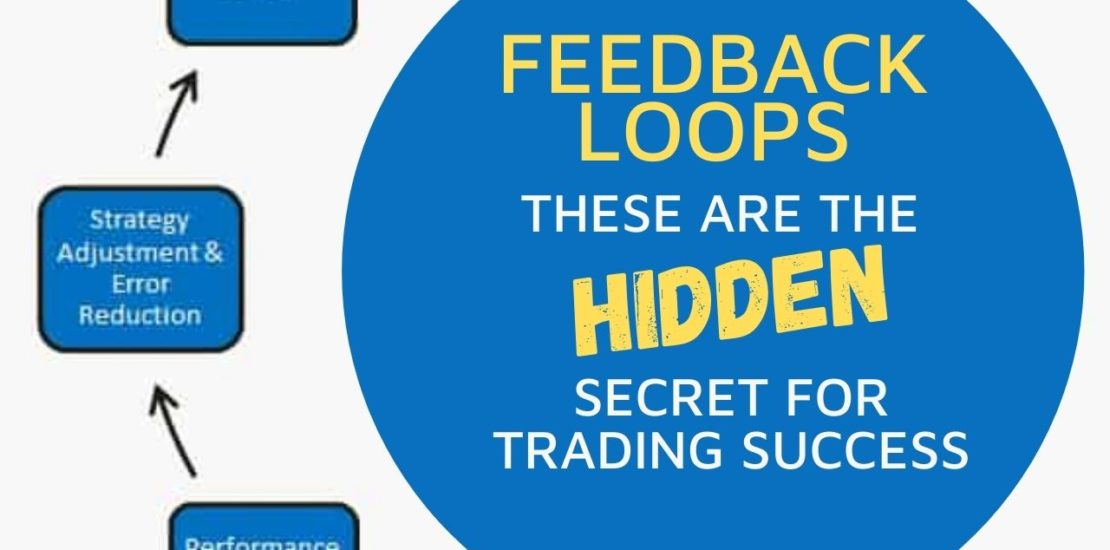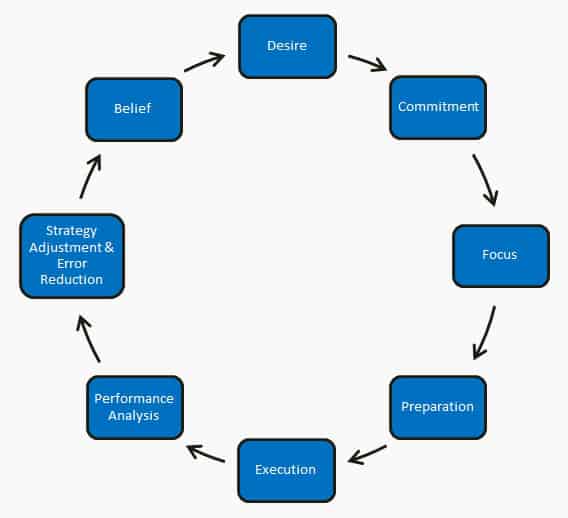- April 19, 2021
- Posted by: Shane Daly
- Category: Trading Article

Succeeding at trading is more than using trading indicators and price action. Forming good habits and breaking old ones is important to anyone who is trying to become good at something. and that includes trading.
If you want to become excellent at what you do and create a long-term sustainable living out of trading, it’s crucial to become effective in consciously forming good habits and breaking bad habits.
To do this, breaking down each step of a habit and then designing your own trading feedback loop can go a long way to putting you on the road to success.
What Is A Trading Feedback Loop?
A trading feedback loop is the act of trading, performance analysis, strategy adjustment and goal setting, all in a self-perpetuating loop.
Done correctly, a loop should accelerate the learning process and magnify your efforts to find trading success.
Done poorly or not at all, you’ll find that you are constantly getting nowhere fast by inaction and poor habits.
A trading feedback loop should be designed so that you are actively working on how to improve your results rather than wandering through the trading world without a clear idea of where you are going and how you wish to get there.
That often leads to bad habits forming.
Good Habits vs. Bad Habits
A trading feedback loop can be categorized into two different groups as James Clear highlighted in his post on feedback loops.
James describes them as
- Balancing Feedback Loops
- Reinforcing Feedback Loops
The difference to whether a loop falls into one category or the other depends on whether you are trying to reduce the occurrence of a bad habit (balancing) or encourage the act of a good habit (reinforcing).
The interesting thing with trading is that because we tend to get better results when we reduce bad or increase good habits and worse results when we increase bad or reduce good habits, the type of feedback loop we’re targeting becomes a little confusing.
Reinforcing trading feedback loop
A reinforcing trading feedback loop might be staying focused and making sure that you take every occurrence of a particularly high probability setup.
Balancing trading feedback loop
A balancing loop might be reducing the habit of self-distraction (internet browsing, social media, emails etc.) when you are fully aware that the high probability setup is likely to occur.
Because of this kind of duality in many trading feedback loops, the task becomes harder.
Harder because you are trying to switch directly from bad habits to good habits.
Completing the Loop
The basis of the feedback loop described is to:
- Measure
- Compare
- Adjust
While this is a good basis, there are additional pieces to a loop if you are attempting something big……like becoming a successful trader.
Here is an example of a trading feedback loop that you can use as a jumping off point.
This example far exceeds the bare bones loop that is required.
What needs to be added to the basic feedback loop to make it an effective, self-perpetuating system?
There has got to be Desire.
But desire to succeed in trading is all too often founded in desire to make a ton of money. The truth is that with that type of desire, you are setting yourself up for failure. You will go through periods where not only do you not make money, you will lose it.
Desire to succeed because you are passionate about trading will give you an edge in itself.
Learning a new skill is usually not easy.
It takes time and effort to master most things. But when you trade, most people start off by trying to learn themselves. They are their own teachers and the only source of feedback they have is themselves.
Understanding concepts, the value of key skills and recognizing where you are in the process are all things that need to be considered if you are going to make the best use of your time.
You may not be the best person to assess what you need to be doing.
This is precisely the same for goal setting.
To assess performance, there must be a goal that’s realistic for you. If you set goals that you are never going to be able to achieve, the chances are high that you’ll become demotivated and quit.
Finally, from all that you gain from each stage of your feedback loop, it must lead to a situation where you have a deep sense of belief that what you are doing and how you are adapting and learning, is getting you closer to your overall goals.
Points of Failure
There’s another interesting point James Clear makes in his post.
It’s about where feedback loops fail.
Feedback loops are not rocket science. But they frequently fail, probably through inadequate planning and accounting for problems in implementing things properly.
The reasons he cites for loop failure are:
- Measurement is not automatic
- Comparison is irrelevant
- Feedback is slow
Automatic or at least easy measurement of performance makes a big difference.
Having to manually record everything isn’t difficult but to many traders it’s just another chore that they don’t want to be bothered by at the end of a stressful trading session.
But failing to take the time when the information is fresh can lead to you not capturing all the information that you need.
Irrelevant comparison reflects what I’ve already noted about not understanding what it is you need to be doing.
Thinking that you’re failing because you are just not making any money after a year of trading isn’t a good conclusion to draw.
It may be that you are not trying to form good habits and do the right things, so in fact you are failing, but not simply because you are not making money.
Slow feedback is a killer for harnessing the potential power that a trading feedback loop has.
My personal view is that traders who on average are taking one or fewer trades per day (and in fact it’s desirable to take more) are significantly handicapping their learning process.
More trades equals more feedback. Just to be clear, in no way am I suggesting you over trade or see something that isn’t there just to push buttons.
More trades that follow your trading plan is the key.
Loops Are Powerful
Trading feedback loops are powerful, but so frequently people leave the learning process to chance, assuming or hoping that they will be good enough to navigate the journey. You might be one of the few who somehow just gets there, but the odds of that are not in your favor.
Do the work required and you will have better odds of succeeding above those that just wing it.
1 Comment
Comments are closed.


Thanks Toby.